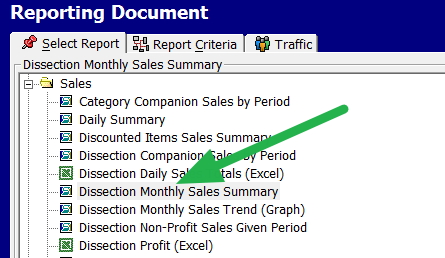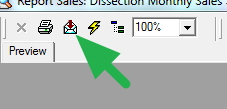
I see many retailers, I can tell you those that do better are those who plan, that have a focus and evaluation their performance. To many get bogged down in day-to-day problems they forget the big picture. To be successful you need to create an information structure, manage, review your business and act.
The first step is to create a sales budget and in less than five minutes, you can make one with our point-of-sale system.
Go into reports,
Now select in sales, the "Dissection Monthly Sales Summary" ( see the green arrow)

Now for the options, select the period. In our marketspace, almost everyone uses two years because they get some history and easy comparisons. It is easy to relate too and gets out of the complexities of seasonally adjusted figures. In my experience, its best to work as well with financial dates.
Although of course you can select how many and what dates you want, it's your choice.
Now I got a report of two-year history, of each department.
I then on the top right, press the export button and nominate to excel.

Now you will get two years of history for each department. You can use them create a budget for next year. You can if you want use excel formulas to create a budget, there is one called forecast specially written for this, but I think its best to use your experience here plus the mathematics. Say, for example, toys were $1,900 two years ago; last year was $2,130, I would say another $200 are possible and make it $2,300. Now adjust this by your experience.
Some people prefer to make these budgets a bit high, so they can make it a challenge. Some would say its better to fail making $2,500 with a $2,700 budget then making budget at $2,300. The problem here is that in practice, you tend to start to ignore these budgets as you cannot make it.
Some managers prefer to make them a bit low. That way, it's not hard to make budget, and they look good if it comes in over budget.
So I think you are better off making them realistic and fair by making it something that we can make! If you do not make it, there should be no excuses, now something was wrong either in the planning or the market, which is it? If planning what should you know? If it's the market, what is happening out there?
If you do make it, then clearly you know the market, now what can we have done better.
If you exceed it, okay what do we not know or what did we do right here?
A common rule used is that the budget figure per month, over a year should give two months way below, two-month way above and the rest about what was expected.
The most important thing is that these plans are made. They are dynamic and are communicated to everyone involved. That the results are compared to what was projected.


